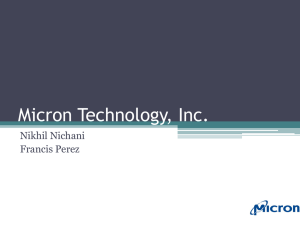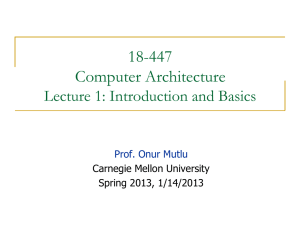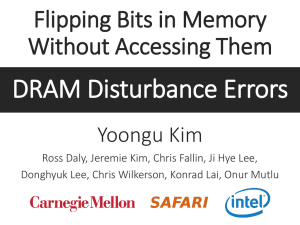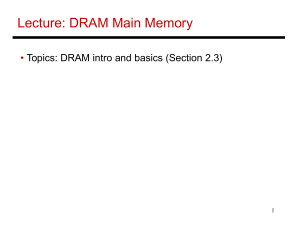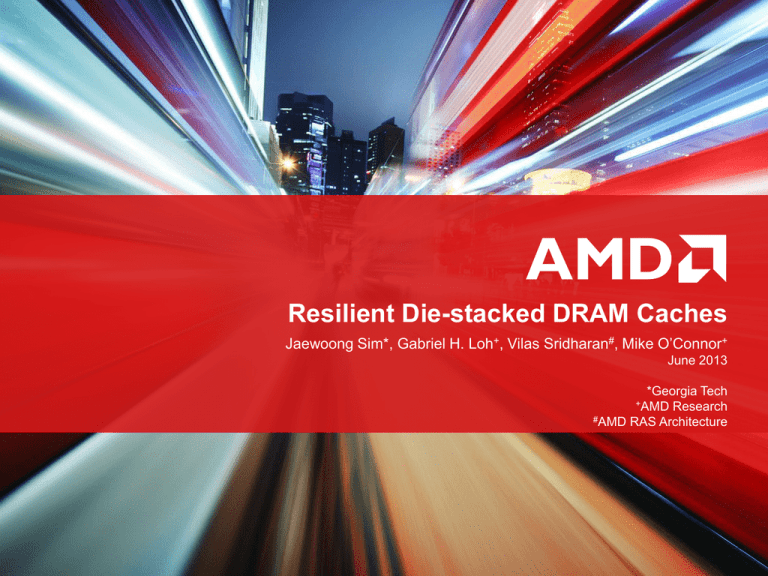
Resilient Die-stacked DRAM Caches
Jaewoong Sim*, Gabriel H. Loh+, Vilas Sridharan#, Mike O’Connor+
June 2013
*Georgia Tech
Research
#AMD RAS Architecture
+AMD
DIE-STACKED MEMORY
Die-stacking is coming along, esp. DRAM
– JEDEC Wide-IO and HBM standards
– Micron Hybrid Memory Cube™
For the time being, likely to be utilized in more
expensive, higher-end product segments
– HPC, Data-Center, Gaming/Enthusiast GPU
For HPC, Data-Center, may not be able to
stack enough DRAM for target capacities
DRAM
layers
cores
DRAM
layers
cores
– Perhaps for some segments or Cloud
application classes, but not for others (e.g., HPC)
Past work has explored how to utilize stacked
DRAM as a large, SW-transparent cache
silicon interposer
– E.g., the previous excellent EPFL talk
RESILIENT DIE-STACKED DRAM CACHES | JUNE 2013 | PUBLIC
2
SERVICEABILITY
Die-stacked DRAM changes the Serviceability of memory
Conventional DRAM:
X
$
Stacked DRAM + CPU:
$$$
RESILIENT DIE-STACKED DRAM CACHES | JUNE 2013 | PUBLIC
3
RAS NEEDS IN HIGH-AVAILABILITY SYSTEMS
Soft errors
– Transient errors (high-energy particle strikes, PVT)
Hard failures
– Very common in practice
– Example: ORNL’s Jaguar cluster [Sridharan+ SC12]
• 41% transient faults, 59% permanent
• Many “coarse-grain failures”, e.g.,
row-level, entire bank
Fault-tolerance critical in HPC
– Scientific simulations can take weeks to
months; uncorrectable errors are very
expensive (even with checkpoint restore)
– Even worse: Silent Data Corruption
Fault Type
FIT Rate
Single-bit, transient
14.2
Single-column, permanent
5.6
Single-row, permanent
8.2
Single-bank, permanent
10.0
• Months of simulation for a wrong answer, and you don’t even know it
RESILIENT DIE-STACKED DRAM CACHES | JUNE 2013 | PUBLIC
4
FLEXIBILITY AND COST
Conventional DRAM uses the same chips for non-ECC and ECC DIMMs
ECC DIMM
Data: Eight x8 DRAM chips
Non-ECC DIMM
Data: Eight x8 DRAM chips
ECC: One x8 DRAM chip
Memory vendor only needs to design a single DRAM chip
– +12.5% storage for SECDED: just add one (x8) or two (x4) extra chips
– DIMM PCB design a lot cheaper
RESILIENT DIE-STACKED DRAM CACHES | JUNE 2013 | PUBLIC
5
HOW TO ADD 12.5% STORAGE TO 3D DRAM?
Make row 12.5% wider?
– Memory vendor must support two different ICs
Add more chips?
Must have 8 chips
RESILIENT DIE-STACKED DRAM CACHES | JUNE 2013 | PUBLIC
Not practical;
Stacking concerns
(½ wasted)
4 DRAM chips (data)
½ DRAM chip
for ECC (?)
4 DRAM chips (data)
8 DRAM chips (data)
9th DRAM
chip (ECC)
5th DRAM
chip (ECC)
Wasteful
Extra cost
6
DIE-STACKED DRAM ORGANIZATION
“DIMM-style” ECC for stacked DRAM is expensive
128b
3D DRAM uses wide buses
– E.g., JEDEC HBM has eight
independent 128-bit channels
Single-point of failure
– Chip-kill works because data are
spread out over multiple physical
units of failure
RESILIENT DIE-STACKED DRAM CACHES | JUNE 2013 | PUBLIC
32b 32b 32b 32b
Accessing multiple chips
– Wastes channel/command BW
– Reduces opportunities for BLP
– Wastes power (multiple activations)
7
EXECUTIVE SUMMARY SLIDE
Comprehensive error-detection and correction for DRAM caches
– Basic error correction: all single-bit upsets correctable
– Coarse-grain error correction: 99.9993% of single-column, row, and bank failures
– Superior SDC protection: 5 orders of magnitude reduction in SDC FIT rate
compared to basic SECDED ECC
Many existing techniques, synthesized specifically for DRAM caches
–
–
–
–
Basic SEC (no extra detection) for common single-bit upsets
CRC for very strong multi-bit detection
Address/index hashing for decoder failure detection
Duplicate-on-Write: RAID1-like approach for correction
Low-cost, Flexible, and General
– Works with non-ECC, unmodified stacked DRAM
• HBM-like interface used in this study
– Can be optionally enabled for different market segments/needs
– A specific design is presented, but this is a general framework to support RAS in
DRAM caches
RESILIENT DIE-STACKED DRAM CACHES | JUNE 2013 | PUBLIC
8
BASIC ERROR
DETECTION AND
CORRECTION
DRAM CACHE REVIEW
To mitigate space overheads of external tag overheads, tags and data are
co-located with DRAM rows
– Loh and Hill [MICRO11] developed initial set-associative solution
– Qureshi and Loh [MICRO12] proposed direct-mapped organization for latency
Both use unmodified stacked DRAM: tags and data laid out differently, but the
underlying storage is just a standard DRAM row
Key observation: tags, data (and anything else) are fungible
– Can allocate more or less of one type or the other; just depends on how the
memory/cache controller interprets what’s stored in a row
RESILIENT DIE-STACKED DRAM CACHES | JUNE 2013 | PUBLIC
10
EMBEDDING ECC IN A ROW
RESILIENT DIE-STACKED DRAM CACHES | JUNE 2013 | PUBLIC
11
ENHANCING ERROR DETECTION (FOR SDC)
CRCs provide much higher levels of error detection
– Spatially clustered errors
– 16-bit CRC can detect:
•
•
•
•
All errors up to 5 (i.e., pentuple-error detect) in the tag (including its SEC)
All errors up to 3 in the data
Burst errors up to 16 bits
All errors with an odd number of erroneous bits
Sacrifice some capacity to store the extra CRCs (25 vs. 28 cachelines per row)
Artifact of the sizes/packing: data has separate SEC code per half-cacheline
RESILIENT DIE-STACKED DRAM CACHES | JUNE 2013 | PUBLIC
12
PERFORMANCE IMPACT
Latency increases by one memory clock for ECC check
Tag update increases to compute new CRC (on a write)
Capacity reduced for CRC case
-0.5% (-2.4%
of speedup)
-1.7% (-8.2%
of speedup)
See paper for full methodology details. 4-core, multi-programmed SPEC06 workloads; per-core
L1 caches, shared L2, and shared L3 DRAM cache (8 x 128-bit channels)
RESILIENT DIE-STACKED DRAM CACHES | JUNE 2013 | PUBLIC
13
COARSE-GRAIN
FAILURES
TYPES OF FAILURES
Multi-bit upset
– Smaller cells can increase likelihood that a particle strike upsets more than one cell
• SEC(DED) only corrects one bit; higher-level codes are expensive
Read/write circuitry or bus failure
– 64B cache line = 512 bits 4 bits of data transmitted per bit of the bus
• A failed driver, broken TSV, etc. causes up to 4 incorrect bits (again, too much for SEC)
– Problem in the address decoding
path could lead to the wrong
wordline being asserted
• Standard ECC can’t help you here
Row 110001
Row Decoder
Row decoder failure:
X
Y
E(X)
E(Y)
Row 101110
Row 101111
Row 110000 accessed row
Row 110001 requested row
Row 110010
Entire bank failure
– Power delivery problem, precharge/timing
circuitry failure, bank decoder failure
Entire channel failure
ECC
No error!
– Similar to above
RESILIENT DIE-STACKED DRAM CACHES | JUNE 2013 | PUBLIC
15
FIRST STEP: DETECTION
CRC catches errors within a row
– Multi-bit errors
– A failed row, bank, channel likely to generate garbage output – CRC will catch these
For decoder errors, use technique like Argus [Meixner+ MICRO’11]
10111010101001001001010110110101
ECC
01001011
cat
1100001100001100001100001100001100001100
XOR
0111100110101000101001010111011001000111
N copies of row index (110000)
XOR
10111010101001001001010110110101 01001011
RESILIENT DIE-STACKED DRAM CACHES | JUNE 2013 | PUBLIC
ECC checks out
16
FIRST STEP: DETECTION
Say we now request row 110001, but due to a decoder fault,
we are given row 110000 instead
Row Decoder
Row 110001
1100011100011100011100011100011100011100
Row 101110
Row 101111
Row 110000 accessed row
Row 110001 requested row
Row 110010
0111100110101000101001010111011001000111
N copies of row index (110001)
XOR
10111110101101001101010010110001 01011011
RESILIENT DIE-STACKED DRAM CACHES | JUNE 2013 | PUBLIC
ECC detects multiple errors
17
INSPIRATION FROM DISK: RAID-1
Store redundant copy (copies?)
– See “In Cache Replacement” [Zhang+ DSN’03]
Bank 0
Bank 1
A
Bank 2
Bank 3
Bank 4
Bank 5
A
C
Bank 6
C
B
B
D
ECC fail
Bank 7
D
Correct
Simple: original in bank x, place copy in bank x+4 (mod 8)
ECC/CRC detects corruption
Read value from duplicated copy
– Repair original
Works, but very expensive (half of your cache capacity is gone)
RESILIENT DIE-STACKED DRAM CACHES | JUNE 2013 | PUBLIC
18
DUPLICATE-ON-WRITE
RAID-1 for disk: no backing store
DRAM cache: off-chip (main) memory still has a copy
– If corrupt, just re-read from main memory
– Similar to parity-protection of I$
• Instructions never modified
But DRAM$ can have modified data
DRAM$
A
A
Only duplicate data on writes
– Capacity impact function of number
of dirty cachelines
– In the worst case (entire cache is
dirty), still could lose 50% of capacity
B
Stale
DRAM$
B
B
• Doesn’t happen in practice
Write
Examples show duplication across banks for simplicity, but by duplicating
across channels we get “channel-kill” protection
– If there are multiple DRAM stacks, then even “stack-kill” is plausible
RESILIENT DIE-STACKED DRAM CACHES | JUNE 2013 | PUBLIC
19
PERFORMANCE IMPACT
Full duplication (RAID-1) clearly not good
Dirty duplication (DOW) relatively effective
– Speedup reduced from 19%18% (1% loss, or 5.3% of DRAM$ benefit)
– Benefit: we can correct (almost) any error that we can detect
• Exceptions are very rare (e.g., original and duplicate copy both corrupted beyond repair)
RESILIENT DIE-STACKED DRAM CACHES | JUNE 2013 | PUBLIC
20
OTHER PERFORMANCE BREAKDOWNS
See the paper for:
– Breakdown of how capacity reduction vs. latency/bandwidth effects impact
performance
– Analysis of additional write-back traffic due to DOW
– Analysis of amount of dirty data in the cache due to DOW
– DRAM cache size sensitivity analysis
– Additional performance results for additional workload combinations (210)
RESILIENT DIE-STACKED DRAM CACHES | JUNE 2013 | PUBLIC
21
FAILURES AT SCALE
Raw FIT rates obtained via Monte Carlo simulation
– SDC FIT: number of SDC events per billion device hours
– DUE FIT: number of Detectable Uncorrectable Errors per BDH
– Assumed two device failure models: (1) Same as today, (2) 10x worse
Failure Rates
No RAS
ECC Only
ECC+CRC
DOW
SDC FIT
234
41
0.0008
0.0008
DUE FIT
0
37
52
0
Assume 100,000-node HPC system, four DRAM stacks per node
MTTF
No RAS
ECC Only
ECC+CRC
DOW
SDC
10 hours
60 hours
350 years
350 years
DUE
n/a
68 hours
48 hours
n/a
RESILIENT DIE-STACKED DRAM CACHES | JUNE 2013 | PUBLIC
22
SUMMARY &
CONCLUSIONS
GENERALITY
Paper provides a specific example implementation
– But this is really a framework, for example:
• SEC, DEC, or other for tags and data?
• Other detection/coding algorithms besides CRC?
All works with commodity stacked DRAM interface
– No changes from memory vendors needed
– All of the logic is in the DRAM-cache controller
Mix-and-match features as needed
– Cache controller can be designed to support more than one mode, for example:
•
•
•
•
•
No RAS (highest performance, have full DRAM cache capacity)
ECC-only
ECC+CRC
ECC+CRC+DOW
Varying levels of any of the above (e.g., SEC ECC vs. DEC ECC)
– May not be able to change “on the fly” (i.e., need a reboot, or at the very least a
cache flush), but don’t need to buy a completely new processor or system
Relatively small performance overhead for very high levels of RAS
RESILIENT DIE-STACKED DRAM CACHES | JUNE 2013 | PUBLIC
24
OTHER DIRECTIONS
What to do after a bank/channel/stack goes down?
– Sparing mechanisms
– Remapping of cache around failed resource(s); i.e., capacity reduction
DiRT for limiting dirty data to reduce DOW impact
– Dirty Region Tracker mechanism proposed by Sim et al. that bounds the amount of
dirty cachelines in the DRAM$ [Sim+ MICRO’12]
Scrubbing/“Rinsing”
– Periodic error correction to prevent accumulations of multiple bit errors
– Periodic writeback of modified data to reduce DOW impact
System interactions
– Allow OS or other software to specify pages (or other granularity) to protect or not
protect (or at what level)
– If error corrections happen too often, alert OS and possibly reconfigure the RAS
mechanisms for higher levels of protection
RAS for non-cache 3D DRAM?
– This work focused on die-stacked DRAM as a cache; for some markets, the
entirety of main memory may be stacked… how to provide RAS support?
RESILIENT DIE-STACKED DRAM CACHES | JUNE 2013 | PUBLIC
25
SUMMARY
Comprehensive error-detection and correction for DRAM caches
Many existing techniques, synthesized specifically for DRAM caches
Low-cost, Flexible, and General
Questions?
RESILIENT DIE-STACKED DRAM CACHES | JUNE 2013 | PUBLIC
?שאלות
26
DISCLAIMER & ATTRIBUTION
The information presented in this document is for informational purposes only and may contain technical inaccuracies, omissions and
typographical errors.
The information contained herein is subject to change and may be rendered inaccurate for many reasons, including but not limited to
product and roadmap changes, component and motherboard version changes, new model and/or product releases, product differences
between differing manufacturers, software changes, BIOS flashes, firmware upgrades, or the like. AMD assumes no obligation to
update or otherwise correct or revise this information. However, AMD reserves the right to revise this information and to make changes
from time to time to the content hereof without obligation of AMD to notify any person of such revisions or changes.
AMD MAKES NO REPRESENTATIONS OR WARRANTIES WITH RESPECT TO THE CONTENTS HEREOF AND ASSUMES NO
RESPONSIBILITY FOR ANY INACCURACIES, ERRORS OR OMISSIONS THAT MAY APPEAR IN THIS INFORMATION.
AMD SPECIFICALLY DISCLAIMS ANY IMPLIED WARRANTIES OF MERCHANTABILITY OR FITNESS FOR ANY PARTICULAR
PURPOSE. IN NO EVENT WILL AMD BE LIABLE TO ANY PERSON FOR ANY DIRECT, INDIRECT, SPECIAL OR OTHER
CONSEQUENTIAL DAMAGES ARISING FROM THE USE OF ANY INFORMATION CONTAINED HEREIN, EVEN IF AMD IS
EXPRESSLY ADVISED OF THE POSSIBILITY OF SUCH DAMAGES.
ATTRIBUTION
© 2013 Advanced Micro Devices, Inc. All rights reserved. AMD, the AMD Arrow logo and combinations thereof are trademarks of
Advanced Micro Devices, Inc. in the United States and/or other jurisdictions. Other names are for informational purposes only and may
be trademarks of their respective owners.
RESILIENT DIE-STACKED DRAM CACHES | JUNE 2013 | PUBLIC
27



